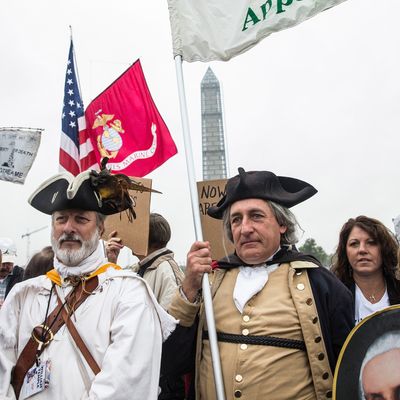
Pragmatic conservatives warned their tea-party brethren that shutting down the government would not harm Obamacare and would instead harm the Republican Party. And lo, both halves of the prophecy have now come to pass. New polls by CNN and the Washington Post measure the damage. Both polls show Democrats taking an 8-point lead in the generic ballot for Congress — a result that, if it held up, would likely depose the Republican majority. The election is a year away, and everybody expects the damage to subside. But deeper reputation damage can be detected. CNN asks voters if they consider each party “too extreme” or “generally mainstream.” By a 52 percent to 42 percent margin, they deem the Democrats generally mainstream. By a 56 percent to 37 percent margin, they call Republicans too extreme. The shutdown may not have been an act of suicide — there’s plenty of time to recover — but it was surely a suicidal gesture.
In the wake of the debacle, reporters and mortified Republican pragmatists alike have attempted to reconstruct the erroneous thinking that led the GOP to undertake a doomed strategy. There certainly were elements of legitimate miscalculation at play. (The simplest and least appreciated is that many of them initially believed shutting down the government would halt Obamacare, and by the time they learned otherwise, they had already printed up the T-shirts.)
In the most important ways, though, the tea party’s strategy was not a strategy at all. On the surface, demanding an end to Obamacare in return for reopening the federal government was an insane negotiating strategy. Attempting to analyze these demands in strategic terms misses the point. It’s not a plan to achieve a defined legislative end. It’s a demonstration of dissent from a political faction that has no chance of winning through regular political channels. The problem they are attempting to solve in each case is not “how do we achieve this policy objective?” but “how can we express our outrage?”
It is certainly unusual to see a major political party engaging in the politics of demonstration as though it were a marginal bloc of social activists. This reflects the deep vein of pessimism that has run through the right since the Obama era. I tried to capture it in my story a year ago, “2012 or Never,” which analyzed the widespread conservative belief that the last election represented a final chance for the old Reagan coalition to hold back Barack Obama’s America — which they imagined, in a distorted but not altogether false way, as racially polyglot and addicted to the spoils of redistribution.
Jim DeMint, who spearheaded the shutdown from his current perch at the Heritage Foundation, laid out the frantic time-is-slipping case in his book last year, Now or Never. The now-or-never analysis was not confined to the tea-party wing. Paul Ryan warned that the country was on the brink of a “tipping point”: “The tipping point represents two dangers,” he announced in a speech at the American Enterprise Institute, “first, long-term economic decline as the number of makers diminishes [and] the number of takers grows … Second, gradual moral-political decline as dependency and passivity weaken the nation’s character.”

They did not believe that Republicans would never win an election again. They believed that the old conservative coalition was expiring as a national majority, that the slow post-recession growth under Obama gave the party one last chance to reshape the face of government in 2012, after which traditional conservative governance would become virtually impossible. A Republican strategist, in the waning days of the 2012 election, told Ron Brownstein, “This is the last time anyone will try to do this” — “this” being a presidential campaign that tries to assemble a majority almost entirely through white votes.
Mitt Romney’s defeat inspired different wings of the party to differing conclusions. Yet, in a strange way, they all followed logically, if not rationally, from the 2012 or Never analysis. One wing of party moderates, mostly clustered around a handful of reformist intellectuals, identified the GOP’s weakness as its economic identification with the interests of the rich. A second cluster, associated with the party leadership and such figures as Marco Rubio and Paul Ryan, set out to preserve the party’s economic platform while broadening its social appeal by embracing immigration reform and gay rights. Economic reformers and social reformers generally blocked one another’s efforts, and both were blocked by the tea party, which opposed any compromise with the electorate.
The pollster Stan Greenberg held extensive focus group discussions with tea party voters and described their worldview in detail. Their most intense and passionate belief was that Obama has used the power of expanded government to build a majority voting coalition:
the most passions among Evangelicals and Tea Party Republicans — that big government is meant to create rights and dependency and electoral support from mostly minorities who will reward the Democratic Party with their votes. The Democratic Party exists to create programs and dependency — the food stamp hammock, entitlements, the 47 percent. And on the horizon—comprehensive immigration reform and Obamacare. Citizenship for 12 million illegals and tens of million getting free health care is the end of the road.
Lest this sound like a hostile exercise in anthropology, Pete Wehner, a former deputy to Karl Rove and Commentary blogger, endorsed his conclusion as “basically right.” Wehner’s own repeated (though unscientific) exposure to tea-party thought yielded the same grim conclusion:
they believe that America is at an inflection point. That we are about to enter into the land of no return. That demographic trends are all troubling and that the “takers” in America will soon outnumber the “givers.” That for many decades (or more) we’ve seen a “one-way ratchet toward ever bigger government.” And that a majority of Americans will become hooked on the Affordable Care Act like an addict to cocaine.
Wehner argues forcefully against this vein of fatalism. The Republican pragmatists believe Heritage, Ted Cruz, and other hucksters manipulated the tea party into endorsing a doomed maneuver. But the shutdown was the tea party’s attempt to stop Obamacare in roughly the same sense the Days of Rage was Weatherman’s attempt to stop the Vietnam War.
If you watch the video above, you’ll see familiar echoes of the recent events in Washington: far-fetched scenarios, confessions that the effort was worthwhile even if it was doomed, even the Gadsden Flag. Its adherents may have wanted to believe they would achieve their goal, but the lack of any plausible path by which the end might follow the means did not trouble them. The demonstration of outrage was a form of politics well suited for a movement that views itself as a hopeless minority in a democratic process rigged against them. It is a (not the, but a) logical culmination of a movement that loses its now-or-never moment. Everything that has happened since then in Washington: the backlash against Republican efforts at accommodation, the ever greater frenzies of protest, the rejection of traditional notions of compromise and attainability — this is what never looks like.






























